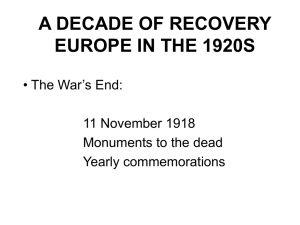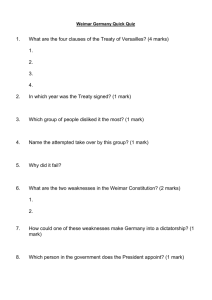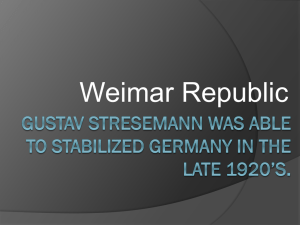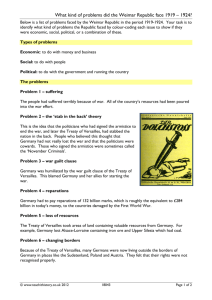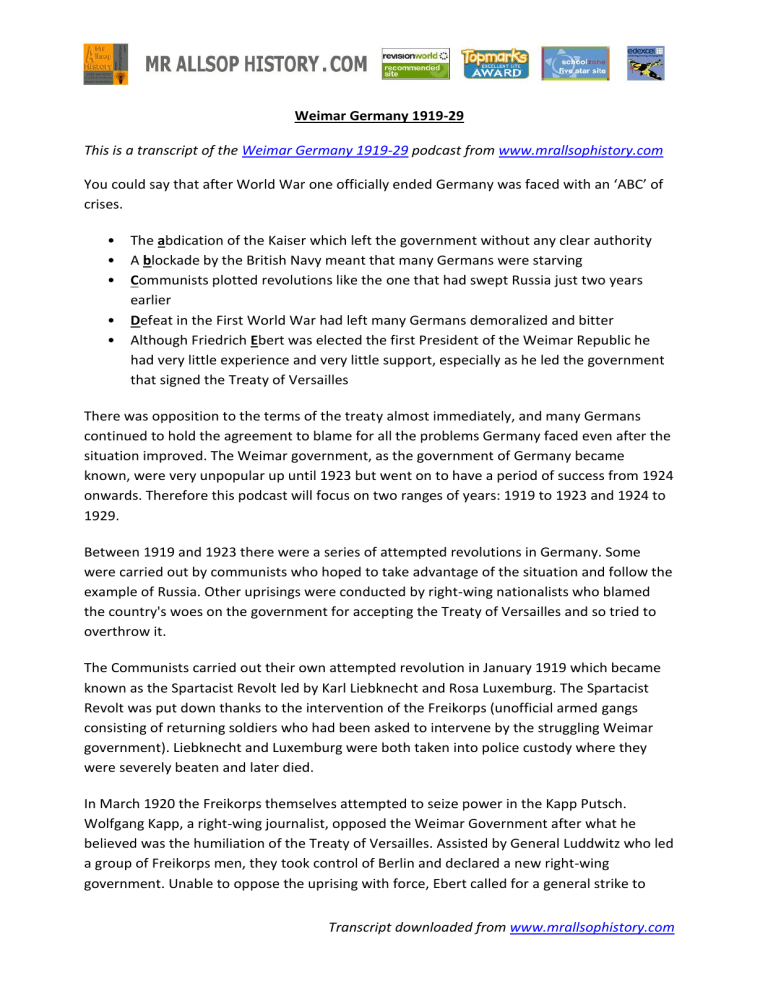
Weimar Germany 1919-29 This is a transcript of the Weimar Germany 1919-29 podcast from www.mrallsophistory.com You could say that after World War one officially ended Germany was faced with an ‘ABC’ of crises. • • • • • The abdication of the Kaiser which left the government without any clear authority A blockade by the British Navy meant that many Germans were starving Communists plotted revolutions like the one that had swept Russia just two years earlier Defeat in the First World War had left many Germans demoralized and bitter Although Friedrich Ebert was elected the first President of the Weimar Republic he had very little experience and very little support, especially as he led the government that signed the Treaty of Versailles There was opposition to the terms of the treaty almost immediately, and many Germans continued to hold the agreement to blame for all the problems Germany faced even after the situation improved. The Weimar government, as the government of Germany became known, were very unpopular up until 1923 but went on to have a period of success from 1924 onwards. Therefore this podcast will focus on two ranges of years: 1919 to 1923 and 1924 to 1929. Between 1919 and 1923 there were a series of attempted revolutions in Germany. Some were carried out by communists who hoped to take advantage of the situation and follow the example of Russia. Other uprisings were conducted by right-wing nationalists who blamed the country's woes on the government for accepting the Treaty of Versailles and so tried to overthrow it. The Communists carried out their own attempted revolution in January 1919 which became known as the Spartacist Revolt led by Karl Liebknecht and Rosa Luxemburg. The Spartacist Revolt was put down thanks to the intervention of the Freikorps (unofficial armed gangs consisting of returning soldiers who had been asked to intervene by the struggling Weimar government). Liebknecht and Luxemburg were both taken into police custody where they were severely beaten and later died. In March 1920 the Freikorps themselves attempted to seize power in the Kapp Putsch. Wolfgang Kapp, a right-wing journalist, opposed the Weimar Government after what he believed was the humiliation of the Treaty of Versailles. Assisted by General Luddwitz who led a group of Freikorps men, they took control of Berlin and declared a new right-wing government. Unable to oppose the uprising with force, Ebert called for a general strike to Transcript downloaded from www.mrallsophistory.com paralyse the Putsch. The general strike ensured that those who supported Kapp could not move around. They ran out of supplies, so the push failed and Kapp fled abroad. Despite the defeat of these two major uprisings it was clear that the situation was highly unstable even after the Spartacists and Freikorps had been defeated. There were murders of two government ministers, one of whom had signed the armistice. Furthermore a number of extremist political parties were set up including the German Workers Party which Adolf Hitler took over and renamed in 1921. The government became more and more unpopular and appeared to be very weak because it was not able to deal effectively with the ongoing revolutions and unrest. In 1922 the Weimar government stopped paying reparations. This led to the French and Belgian armies invading the Ruhr – the main industrial area of Germany – which was completely legal under the terms of the Treaty of Versailles. Desperate to avoid helping the invaders, the government called for the German workers to go on strike which only resulted in the French and Belgians bringing in their own workers and cutting the area off from the rest of Germany. In response the government began printing money, partly to pay the striking workers and partly in an attempt to pay off some of its debt. However, the uncontrolled increase of money led to hyperinflation. This is the name given to the massive rise in prices and the devaluation of currency that took place in 1923 and affected everyone in Germany. Since so much money was now floating around the country without there being anything to spend it on the price of goods skyrocketed. Many Germans found that their life savings were lost, and people who lived on pensions were ruined. Prices rose every hour. The effect was that people rushed to buy goods as soon as they were paid in order to avoid further price increases. They bought anything that was available at the time because otherwise their money would lose value immediately. This led to the emergence of a barter system where people exchange goods rather than money, while in some cases shopkeepers did their best to keep their shops closed and avoid selling anything at all. If the situation was so appalling in 1923, how did Germany recover? It all began with the new Chancellor Gustav Stresemann who brought hyperinflation under control and was therefore seen as a good leader by many Germans. Stresemann ordered all the old Reichmark banknotes to be collected in and burned. He replaced them with a new currency – the Rentenmark – which was backed by the land of Germany rather than by gold. Stresemann was also able to deal with a number of other problems facing Germany in the 1920s and so the country began to recover from the effects of the First World War. Ge got German industry going again, and persuaded the French and Belgians to leave the Ruhr by calling off the strike. In 1924 he borrowed money from the USA to help Germany pay its reparations – a loan system called the Dawes Plan. Under the plan America loaned money to Transcript downloaded from www.mrallsophistory.com Germany who used it to pay reparations to Britain and France. They in turn used the money to pay their war debts to America. The flow of money ensured that the countries were able to help their industries recover, and the trade that emerged helped to improve relations between them. Consequently in 1925 Stresemann persuaded the French and Belgians to sign the Locarno Pact in which Germany promised to respect Germany's Western borders as laid out in the Treaty of Versailles. A year after that Germany was admitted to the League of Nations and became a permanent member of the Council. Outside politics there were also achievements in the arts. Painters, playwrights, musicians and authors all helped to make Germany – and Berlin in particular – a famous centre for the arts and music in Western Europe. By the late 1920s therefore it appeared that Germany had recovered from the humiliation of Versailles, and was viewed as an equal by the other countries of Europe. However it's important not to be too blinkered in this view. A popular question on exam papers asks how far Germany had recovered by 1929 and so it's important to remember to include examples that show how there were still problems as well as signs of recovery. You may talk about how traditional Germans disliked the new art movements and felt that the Weimar government was actively destroying German tradition. You might point out that the Weimar Republic was still politically unstable: numerous elections resulted in coalition governments who struggled to work together and led to people questioning the effectiveness of democracy. However, number one on your list will probably be the Dawes Plan. Although the Dawes Plan did untold amounts of good for Germany in the short term, it's important to remember that the new German prosperity was built on loans. If America was to withdraw the funding or demand repayment Germany would be in deep trouble. That is exactly what happened in October 1929 when Wall Street, the American stock exchange, crashed. This led to the Depression that took hold in the 1930s and resulted in the Dawes Plan falling flat on its face. America demanded all its money back from Germany leaving Germany in a frightful economic situation. By 1932 six million Germans were out of work. The desperation felt by the German people led to extreme measures. Less than four years after the Wall Street Crash, Adolf Hitler had come to power. Transcript downloaded from www.mrallsophistory.com
